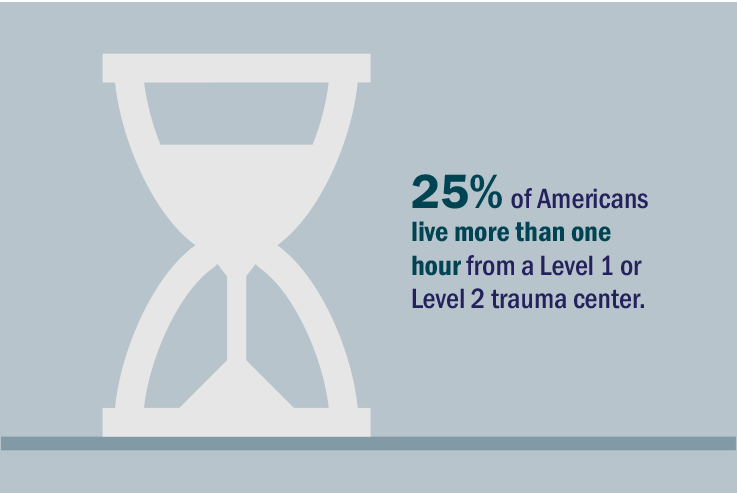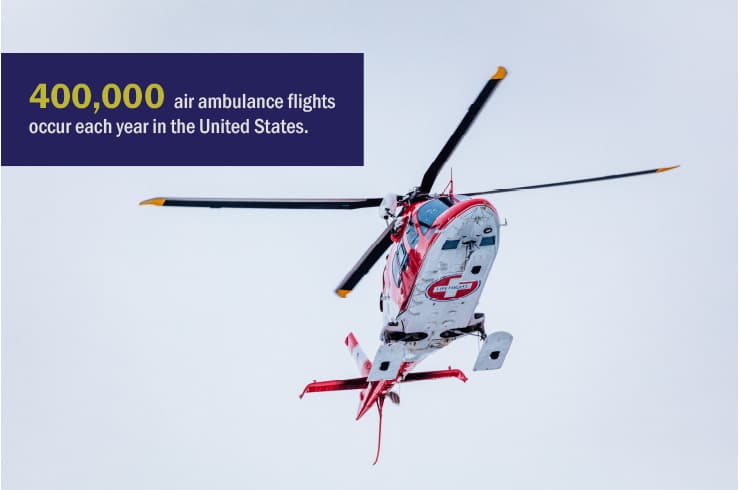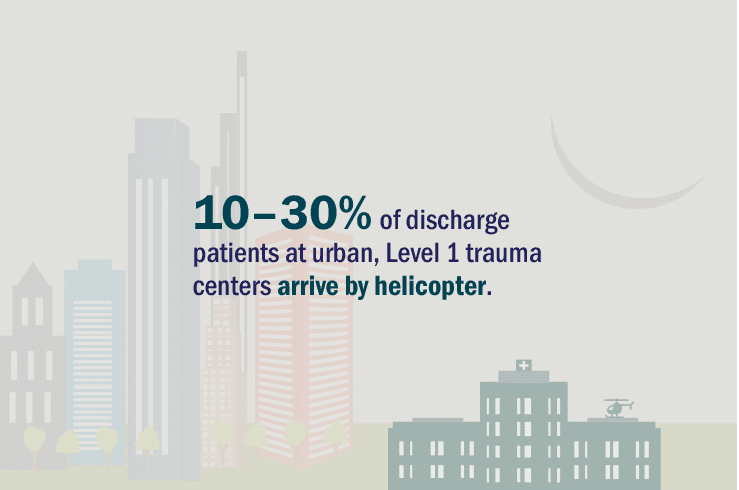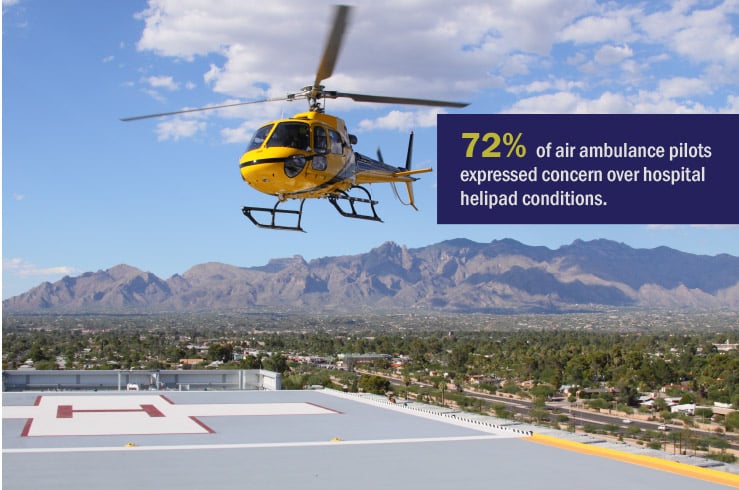Helipad Safety Upgrades for Healthcare Facilities
Seeing no signs of wind, the air ambulance made its descent. At 40 feet, the helicopter spun suddenly out of control, rolling onto its side before crashing on the California hospital’s roof.
Fortunately, no one suffered major injuries. The awaiting transplant patient received their new heart.
Air ambulance accidents remain rare. Still, incidents like this 2020 crash are reminders of the importance of helipad safety. A single accident during takeoff or landing could have dire consequences for crew, passengers, medical staff and healthcare facility occupants.
Outdated helipad equipment and overdue maintenance may expose healthcare facilities to unnecessary risks. Upgrades to meet the latest federal design guidelines can improve safety, facilitate on-going maintenance and improve the resiliency of air ambulance operations in the event of a major disaster.

Source: SOAR Campaign
Growing Reliance on Aging Helipad Facilities
Air medical services are an increasingly critical element of emergency response, especially as healthcare system consolidation becomes more common. Facing narrow financial margins, more than 135 rural U.S. hospitals have shuttered since 2010, leaving one in four Americans more than a mile from a Level 1 or Level 2 trauma center.
Many trauma centers are more than 60 years old, and helipads require regular upkeep. With helipad maintenance falling under the responsibility of facility staff who are generally unfamiliar with the unique responsibilities and considerations of helipad systems, helipads can fall into a state of disrepair.
A further complication is the lack of helipad standardization combined with less-robust regulatory oversight. Healthcare facilities are required to meet state and local building codes, yet helipad design and construction follows unrelated Federal Aviation Authority (FAA) guidelines.
This ambiguity combined with instances of deferred maintenance have led some aircrew to question the quality of helipad design, construction or maintenance. Responding to a recent National EMS Pilots Association survey, more than 70 percent said conditions within their operating areas did not meet generally accepted or current guidelines.

Source: Association of Air Medical Services
Helipad Design and Maintenance Best Practices
In January 2021, FAA released an update to its helipad design guidelines, the first such update in nearly a decade. To determine whether facility equipment, safety procedures and staff training exercises align with current FAA standards and industry best practices, healthcare facilities should engage an aviation engineering expert to conduct a risk assessment and to review the existing helipad conditions.

Source: Journal of Trauma and Acute Care Surgery
The following technology upgrades, design features and maintenance procedures are among helipad facility best practices that healthcare leaders may wish to consider.
Lighting
Antiquated lighting systems are becoming harder to maintain as replacement parts become increasingly scarce. Light-emitting diode (LED) upgrades can improve transport conditions while lowering energy and maintenance costs. More energy efficient than conventional incandescent bulbs, LEDs can produce brighter lighting, improving nighttime landing conditions. LEDs can be visible at greater distances while maintaining required lighting color.
To monitor wind conditions, helipad facilities now have the option of installing various solar-powered, LED wind cones. LED alternatives are 10-times more energy efficient than incandescent windsock lighting. Detached solar systems eliminate the need for trenching, cabling or other electrical services.
In addition, the use of daylight sensors can ensure helipad lighting operates only after dark. An alternative to these photosensors is the use of radio controllers. Approaching pilots can click their microphones a set number of times, triggering helipad lights to turn on.
Snow and Ice Control
To limit the buildup of snow or ice, healthcare facilities can integrate radiant heating systems that warm helipad surfaces to above-freezing temperatures. Tubing placed within concrete or extruded aluminum is connected to a dedicated boiler system or heat exchanger. Modern controls can automatically heat the helipad when temperatures dip below freezing and, if applicable, connect with the existing building automation system (BAS).
Helipad lighting systems can also be retrofit to include heaters on each lighting fixture, preventing snow or ice from blocking lights during nighttime operations.
Electrical
On any airfield, electrical wiring will degrade over time. Cables typically suffer from jacket breaks, affecting transmission. Deicing materials and fuel can seep into the conduits, diminishing their quality.
An electrician should test the cables on a regular basis to ensure the system is operating as designed. Best practice is to replace cables every ten years. A modern BAS can oversee any system faults and notify maintenance staff of immediate outages.
Healthcare facilities should also consider tying the helipad’s lighting system into the essential electrical system (EES). In the event of a power outage, the facility can maintain resiliency of helipad operations by integrating the helipad’s critical electrical systems with the backup power supply.
Structural
In addition to considering conditions for helicopter travel, healthcare facilities must take into account extreme weather risks and plan for how medical teams and patients can safely access the helipad.
For ground-level helipads, a flood zone mapping reassessment is often warranted. In many areas of the country, flood risks are being revised in line with new projections that take into account increasing frequency and intensity of storm events.
On rooftop helipads, guard rails and other safe passage measures should be designed based on aircraft size. As helicopters operating at the facility have changed over the years, helipad designs must respond accordingly. A helipad designed to the H-1 standard, for example, would not be able to accommodate helicopters longer than 50 feet in length. If larger aircraft are using the facility, perimeter lights and guard rails may need to be relocated to provide additional clearance.
TIP: Be sure to conduct a wind wake analysis to ensure engine fumes do not affect indoor air quality. If helipads are located near outdoor air intakes, an improper filtration system risks helicopter exhaust circulating through the air handling system.
Minimize Risks, Lower Costs, Improve Care
Windy conditions that likely contributed to the 2020 California crash may be rare. But it is not unusual for air ambulances to navigate such situations. Their flights often occur at night and in poor weather. The National Transportation Safety Board has found that air ambulances traveling in extreme weather are nearly four times more likely to experience an accident than other helicopters flying under the same conditions.

Source: National EMS Pilots Association
Risks are even greater at older helipads that suffer from complacency or improper maintenance. Proper facility design can improve visibility, facilitate safe access and result in faster response to maintenance issues. Additional benefits include lower operating costs from energy-saving upgrades.
For healthcare providers who want to minimize risks and better position their facility to attract more air transports, now may be the right time for a helipad upgrade.


